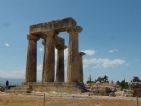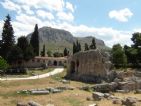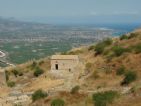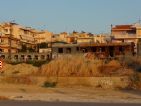
The "three" Corinths.
06/06/2013
Corinth is located in a strategic place that has earned a special place in history. Yet this position is today relatively much less important than it might have been in the past.
As indicated by the Archduke, a great earthquake caused the abandonment of the old Corinth, place that are currently the major archaeological remains, with a new location by the sea.
Arriving from the sea we see the actual Corinth, and we also see that the current image is equal to the Archduke's portrait. On landing we see also the layout of the streets, wide and squared to give in their geometry, the typical aspect of the new colonial cities of the nineteenth century.
In the new Corinth are observed today in an obvious way the impacts of the economic crisis. We see many shops closed and, on the long promenade, abandoned train wagons on railway tracks.
From the boardwalk we took another picture of Corinth to the port. And back we see a magnificent sunset on the Peloponnese mountains.
The next morning we visited Akro-Corinth. The entire area is well signposted but it shows that there are no many people to maintain it. The entrance is spectacular and then are following several lines of defense wich now are entrances.
 Once in the room we see the sources of the Classical period were renovated with Byzantine style. We also see a mosque and a church reflecting different dominations of the city.
Once in the room we see the sources of the Classical period were renovated with Byzantine style. We also see a mosque and a church reflecting different dominations of the city.
 We finally arrive at the top, where are the remains of the temple of Aphrodite. From there we have a magnificent view of the Strait of Corinth. We take the opportunity to include a photo of the Corinth Canal, we could also visit.
We finally arrive at the top, where are the remains of the temple of Aphrodite. From there we have a magnificent view of the Strait of Corinth. We take the opportunity to include a photo of the Corinth Canal, we could also visit.
We go down to the old Corinth now. We see a picture of old Corinth from the hill on which stands Akro-Corinth and other Akro-Corinth image taken from the old Corinth.
In the old Corinth we visited the archaeological remains of Roman Corinth. There we see the fountain of Aphrodite and Temple of Apollo. As did the Archduke we take a picture that you can see six columns (actually there are seven).
Actually at the time in which the Archduke went through the old Corinth, was practically the only thing that looked and remembered the ancient Roman city. We can see a photo taken in the early twentieth century in which we see a large meadow next to the columns and other behind the excavations, as seen today.
Finishing we see a picture of the Odeon and an outline of how it was the ancient Roman city of Corinth, the same that we can now associate with the letters of St. Paul so much repeated in our youth ...
After this visit we'll leave the Gulf of Corinth. We'll be in Lepanto, one of these visits that promise great emotions.

























































